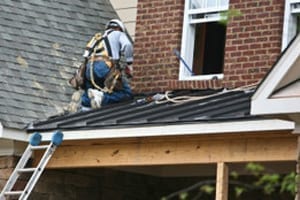
Imagine cooking in your kitchen without an exhaust fan above the stove. As you do, heat, steam, and odors fill the room, making the room uncomfortable and stifling. As the air becomes heavy and stagnant, condensation forms on various surfaces that become inviting environments for mold and mildew.
A roof without adequate ventilation can produce the same effect. As heat and moisture become trapped in the attic, they can damage roofing materials and create problems like leaks, structural decay, and more. Energy efficiency suffers, too, as the unventilated attic becomes extremely hot, increasing cooling demands for your entire home.
The expert roofing contractors at Colonial Contracting, Inc. are here to help you better understand roof ventilation so you can make informed decisions for your home.
Why Is Roof Ventilation Important?
Proper roof ventilation maintains your home’s roof by regulating extreme temperatures and allowing heat and moisture to escape to the outside. It also:
- Improves indoor air quality
- Extends your roof’s life span
- Enhances energy efficiency
- Prevents structural damage
What Are Exhaust Vents?
Exhaust vents remove warm, moisture-rich air from your home’s attic. They’re strategically placed near the roof’s upper area, usually at the ridge or near the peak.
They’re vital to maintaining a functional roof because they expel hot and humid air, preventing its accumulation and the potential damage it can cause.
Types of Exhaust Vents
- Ridge vents are installed along the roof’s peak and are the most popular exhaust vent type.
- Box vents are square-shaped vents that are typically placed near the roof’s ridge.
- Gable vents are installed outside the house on the gable end, where the roof meets the walls.
What Are Intake Vents?
Roof intake vents bring cooler outdoor air into the attic. Placed near the roof’s lower portions, they play a critical role in ensuring proper airflow and maintaining a functional roofing system.
They operate using natural convection. As warm air rises from the exhaust vents, the pressure difference draws in cooler outside air, creating a continuous flow of fresh air that keeps temperatures in check.
Types of Intake Vents
- Soffit vents are the most common intake vents. Located under the eaves, they let air enter the attic from the roof’s lower edge.
- Gable vents can also function as intake vents, particularly when installing soffit vents is challenging due to architectural constraints.
Factors To Consider When Choosing Roof Vents
When selecting roof vents, consider the following:
- Roof design: Depending on your roof’s size, shape, and pitch, your roofing contractor can recommend the best roof vent types and optimal placement.
- Roofing materials: Asphalt shingles have a relatively flat surface, which could contribute to inadequate ventilation. Concrete tile and metal roofing promote better air circulation due to their higher profiles and textures.
- Climate: While warmer climates only have to worry about heat gain and moisture buildup, Northern Virginia has hot, humid summers and snowy winters, so proper ventilation is also needed to prevent ice dams.
- Power: While natural ventilation is sufficient for most homes, roof vents can also be electric- and solar-powered, if needed.
How Many Vents Should a Roof Have?
Most roofing professionals recommend one vent for every 300 square feet of attic space, assuming the attic has a vapor barrier. If it doesn’t, the rule of thumb is every 150 square feet.
The vents should be evenly split between intake and exhaust models. However, you might need more or fewer vents depending on your home’s size, insulation, and other unique features.
Request Roof Ventilation Services in Northern Virginia
Colonial Contracting, Inc. offers comprehensive roofing services, including roof ventilation installation, replacement, and repair.
If you need a roof replacement, you’ll also need to replace your roof vents. Doing so helps prevent the hazards of poor ventilation while enhancing your roof’s performance for years to come.
We offer free, no-obligation roof inspections. We’ll recommend the best solution for your home and install high-quality roofing products for great results.
Contact Colonial Contracting, Inc. online or call 703-754-9551 today to request your roof inspection in Northern Virginia
Trusted by Industry Experts












